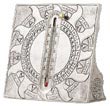A calendar year of 365 or 366 days can never be exactly equal to the solar year as the latter lasts 365 days, 5 hours, 48 minutes and 45 seconds. Over the centuries, attempts to bridge the "gap" between the solar year and the calendar year created considerable confusion.
It seems that when Romulus was alive, in around the eighth century b.C., the calendar year comprised 304 days divided into 10 months. The names of the months were similar to those of today, except for January and February which didn't exist. July was called Quintilis, i.e.: the "fifth month". It was later changed into Julius by the tribune, Mark Anthony, in honour of Julius Caesar who was born in that month. August was called Sextilis, i.e.: the "sixth month". It was later changed by Julius Augustus due to the fact that he had won three victories and put an end to the civil wars in that month. September, October, November and December were initially the seventh, eighth, ninth and tenth months of the year. Legend has it that January and February were added by Numa Pompilius, who thus lengthened the year to 355 days. However, the difference of approximately ten and a half days between the solar year and Numa Pompilius' calendar shortly caused a considerable gap between the seasons and the calendar year.
In 46 b.C., Julius Caesar brought about a new reform. After making the Roman year 708 (46 b.C.) last 445 days, which he called the "ultimus annus confusionis", he established that the year would last 365 days and that an extra day would be added every four years. Following Julius Caesar's reform which led to the adoption of the Julian calendar, the year remained divided into 12 months.
The aim of matching the calendar year with the solar year had not yet been perfectly achieved, though, as the latter was about eleven minutes shorter than 365 and a quarter days. This small difference produces an extra day every 128 years, or about three days every 400 years. The Gregorian reform (which led to the Gregorian calendar) established that the first year of each century that could not be divided by 400 was to be normal (not a leap year). Following the implementation of the Gregorian reform, the errors that had accumulated in the past were corrected: the day after Thursday 4th October 1582 became Friday 15th October, thereby jumping ten days. The Gregorian calendar was subsequently accepted, through gradually, by most civil countries.
It seems that when Romulus was alive, in around the eighth century b.C., the calendar year comprised 304 days divided into 10 months. The names of the months were similar to those of today, except for January and February which didn't exist. July was called Quintilis, i.e.: the "fifth month". It was later changed into Julius by the tribune, Mark Anthony, in honour of Julius Caesar who was born in that month. August was called Sextilis, i.e.: the "sixth month". It was later changed by Julius Augustus due to the fact that he had won three victories and put an end to the civil wars in that month. September, October, November and December were initially the seventh, eighth, ninth and tenth months of the year. Legend has it that January and February were added by Numa Pompilius, who thus lengthened the year to 355 days. However, the difference of approximately ten and a half days between the solar year and Numa Pompilius' calendar shortly caused a considerable gap between the seasons and the calendar year.
In 46 b.C., Julius Caesar brought about a new reform. After making the Roman year 708 (46 b.C.) last 445 days, which he called the "ultimus annus confusionis", he established that the year would last 365 days and that an extra day would be added every four years. Following Julius Caesar's reform which led to the adoption of the Julian calendar, the year remained divided into 12 months.
The aim of matching the calendar year with the solar year had not yet been perfectly achieved, though, as the latter was about eleven minutes shorter than 365 and a quarter days. This small difference produces an extra day every 128 years, or about three days every 400 years. The Gregorian reform (which led to the Gregorian calendar) established that the first year of each century that could not be divided by 400 was to be normal (not a leap year). Following the implementation of the Gregorian reform, the errors that had accumulated in the past were corrected: the day after Thursday 4th October 1582 became Friday 15th October, thereby jumping ten days. The Gregorian calendar was subsequently accepted, through gradually, by most civil countries.

|
|
Вечный календарь настольный (с термометром)
cm 14x14 8940 - IN STOCK |

